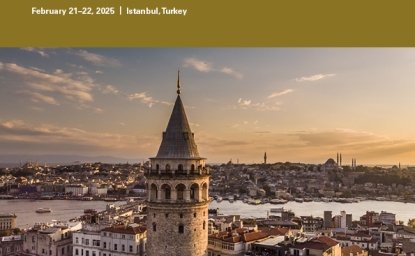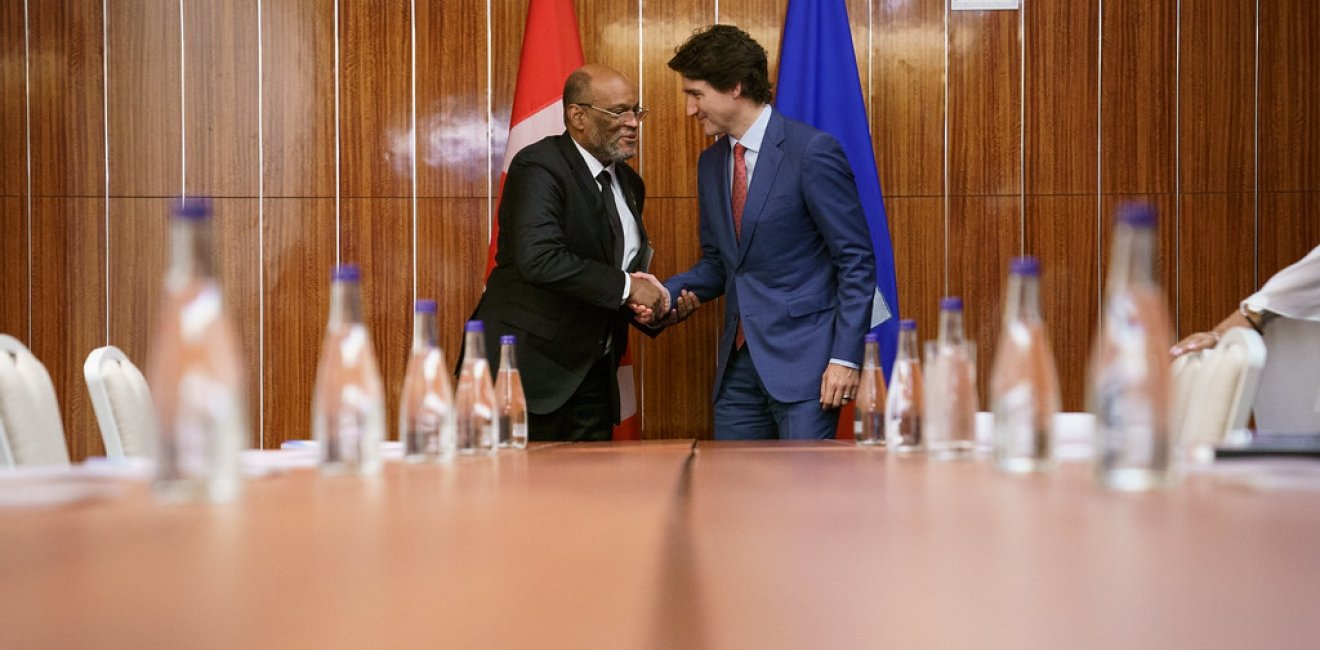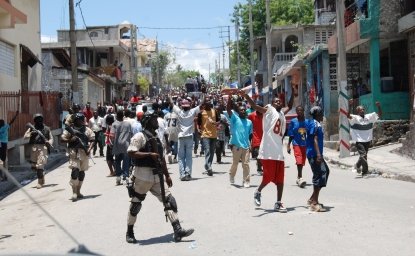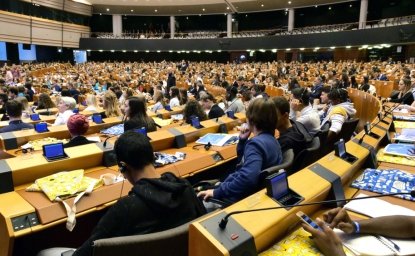Relations between Canada and the United States usually revolve around big issues—how to deal with a world in which Russia and China are posing major new challenges, how to move forward on the global transition to a low carbon future, how to iron out nagging disputes which interfere with our vast trade. But in recent months, the small, deeply troubled Caribbean state of Haiti has risen to surprising prominence in the bilateral relationship.
A Permanent Headache
Haiti’s longstanding problems are well known in both Ottawa and Washington, where policymakers have struggled to address chronic political dysfunction and economic crisis in the Western Hemisphere’s poorest country. Beyond raising humanitarian concerns, instability in Haiti also has led to emigration from the island that has given rise to unwelcome headlines and a perceived need for action.
Haiti’s deterioration has been a perennial headache for the United States, Canada, and other members of the international community. Ever since the death of the “President for Life” Francois “Papa Doc” Duvalier in 1971, it has had the reign of his son Jean Claude “Baby Doc” Duvalier, followed by several military rulers and civilian presidents who have often been unable to serve their entire terms. A terrible earthquake in 2010 greatly added to Haiti’s miseries.
The current phase of the crisis began with the assassination of President Jovenel Moise in 2021 by Colombian mercenaries allegedly hired by his political opponents. His successor, Acting President Ariel Henry, leads a fractured government and it is unclear when new elections will be held.
The country is paralyzed politically while armed street gangs with murky links to different political factions and business interests control much of Port-au-Prince, where the National Police, painstakingly trained and armed by western donors, are unable or unwilling to confront them. Amidst the chaos, the economy is in free fall.
Let’s Ask Canada!
With the situation in Haiti deteriorating and illegal emigration on the rise, U.S. policymakers apparently have seen no alternative to heeding the Henry government’s call for an international stabilization mission, a view also shared by the United Nations. But the United States seems prepared only to provide logistical and financial support, not the needed boots on the ground. For those, it has hoped that Canada would take the lead, together with other countries, possibly from the Caribbean.
In many ways, Canada is a logical candidate: it is the only other sovereign state in the Western Hemisphere where French is an official language and, like Haiti, it is a member of the Francophonie grouping of French-speaking countries. Aside from whatever broad affinity which this may create, it means that Canada has a pool of French-speaking soldiers, police and diplomats which could be deployed.
Canada also has a history of participation in multiple missions to Haiti, including in the United Nations Stabilization Mission in Haiti (known by its French initials as MINUSTAH) which was deployed there from 2004 to 2017. Canada’s presence peaked at 2050 participants in the aftermath of the 2010 earthquake, and was down to 34 by 2013 when it withdrew completely. Canadian ties with Haiti are also reinforced by a substantial presence of Haitian immigrants centered in Montreal.
Thanks, but No Thanks
Despite these longstanding ties and the evident desire on the part of the United States for Canada to step up to the task, Prime Minister Trudeau has been reticent. There is also little support among Canada’s media, political class, or general public (outside of some elements of the Haitian community) for him to send troops to the island.
He has not formally ruled out such a decision but has stressed that the crisis requires “Haitian-led” solutions, a formula also used by the United States and other international actors which are reluctant to intervene directly. Trudeau has also asserted that Canada in fact is “elbows deep in terms of trying to help.” He has twice sent Bob Rae, a former senior political figure and current Ambassador to the United Nations, to Haiti to consult with local actors.
He has also sent a surveillance aircraft to patrol the vicinity to gather intelligence about gang activity in Haiti, though the aircraft has concluded its mission. Two Canadian naval vessels have patrolled along the coast to maintain a “presence” and gain maritime situational awareness. The Canadian Air Force has airlifted armored vehicles which the Haitian government had purchased and Trudeau has pledged 100 million Canadian dollars in financial assistance.
Too Heavy a Lift
Why has the Prime Minister been so reluctant to send soldiers or police to Haiti when, to many observers, it seems the only option that will provide a modicum of stability? First, another foreign military intervention is not likely to be uniformly welcomed. To some, it will be seen as propping up an unpopular regime which lacks democratic legitimacy, even though its presumed goal would be to get Haiti to a position where elections could be held.
Further, the last big effort, that of MINUSTAH, had lost much support by the time it wound down. There were accusations of heavy-handed tactics in patrolling Port-au-Prince’s vast shantytowns. A cholera outbreak was traced to sloppy sanitary practices on the part of MINUSTAH forces. Some local politicians sought to further their own positions by denouncing the mission. And the underlying reality may be that no matter how necessary it may have been, as a foreign military presence, it eventually just wore out its welcome.
MINUSTAH forces left Haiti during a brief period of relative stability. However, as has been the case with interventions elsewhere where the decision to declare “mission accomplished” was based more on more hope than reality, the situation has once again deteriorated. A return to Haiti would likely be painful for Canada or any of the other countries which had participated.
With armed gangs constituting a major security threat, forces would have to patrol the slums with some measure of aggressiveness, which could well both take and inflict casualties. Scenarios of stray bullets whizzing through the walls of shacks and killing innocent children have been drawn by those who are skeptical of intervention. Returning to Haiti would hardly be peacekeeping of the kind in which Canada engaged during the heyday of its interest in such efforts when it led operations in Suez and Cyprus.
But neither would it be Afghanistan, where Canada made a major effort costing 158 lives as part of the U.S.-led NATO effort. Haitian gangs are hardly the Taliban. Still, the shadow of Afghanistan, which, despite a highly professional job done by Canada’s military, ended badly, hovers over policymakers. There is little appetite in Ottawa for open-ended military commitments.
Also, Canada’s military leaders, including Chief of the Defense Staff General Wayne Eyre, have openly expressed doubts about Canada’s capability to lead a mission. Canada’s military expenditures remain relatively low, far from the two percent of gross domestic product which it is theoretically committed to spend as a NATO member.
Despite these self-imposed constraints, Canada has made a credible effort at supporting Ukraine—a far higher U.S. priority than Haiti—through training, the provision of equipment, and financial support. As part of NATO’s Enhanced Forward Presence program in Eastern Europe, it has provided the headquarters unit for a multinational battle group in Latvia, which is now to be increased to brigade strength. Given its overall resource limitations, Canada can make a case that it is doing its part for international security and that someone else will have to take the lead in Haiti.
Instability Leads to Emigration
Canada’s leaders may feel they have been able to demonstrate their engagement in Haiti while avoiding a painful and controversial security commitment. However, as is becoming ever more the case around the world, the transmission belt from international to domestic politics has been illegal immigration.
Periodic spikes in the intensity of Haiti’s crisis have led to abnormal migratory flows. Currently, undocumented Haitians are found in significant numbers throughout the Western Hemisphere, some heading south, and ending up as far away as Chile, with many in Brazil; others heading north, either directly to Florida or to Central America and then overland through Mexico to the porous American border. Existing Haitian communities such as those in Miami, New York, and Montreal are preferred destinations.
Canada is not a country accustomed to illegal immigration, with its three maritime borders and two land borders with the wealthy United States, itself a major pole for immigrants. But in 2017, it found an unexpected flow of immigrants from among the 59,000 Haitians already in the U.S. who had qualified for “Temporary Protected Status” granted following the 2010 earthquake, who now feared that the Trump administration would force their return.
These Haitians could not simply cross into Canada from the United States at ports of entry and then ask for asylum, as Ottawa and Washington had a “safe third country agreement” under which such entrants from one country to the other are returned to the country from which they exited—from Canada to the U.S. in most cases. However, as a result of what was apparently an oversight in drafting, this only applied to persons claiming asylum at formal border posts; those irregularly crossing in between them could in fact claim asylum and be allowed to enter Canada while their cases were being adjudicated.
Welcome to Roxham Road
Haitians began to cross at a location without any border control infrastructure at the town of Champlain on the New York-Quebec border, 38 miles south of Montreal, called Roxham Road. This small thoroughfare became a synonym for illegal immigration in Canada. Over time, a small industry developed of shuttles taking would-be immigrants from Plattsburgh, New York to the Roxham Road crossing. Humanitarian-minded individuals provided aid to these people prior to crossing, after which they were briefly arrested by the RCMP and then turned over to the Canadian Border Services Agency to process them and arrange for temporary shelter in Canada.
While the 2017 spike of Haitians crossing dropped off once U.S. courts halted the Trump administration’s attempt to end Temporary Protected Status for Haitians and others, it resumed with Haiti’s current round of troubles. New entrants were joined by Venezuelans, Nigerians and others who had discovered this loophole. This led the Canadian government to seek the revision of the safe third country agreement to extend it to irregular crossings, to which the United States agreed during President Biden’s March 23-24 official visit.
How effective this will be in stemming the flow of illegal Haitian and other immigrants remains to be seen, and it should be noted that the safe third country agreement with the United States faces a legal challenge before Canada’s Supreme Court, which argues that returning these asylum seekers to the United States is inconsistent with Canada’s obligations under international conventions.
This will be reviewed at a time when the United States seems ever less inclined to let would-be asylees stay in the country pending adjudication of their cases. This can be seen by the policy of “remain in Mexico” which the Trump administration applied to asylum seekers at the southern land border, and which still remains effect while the Biden administration looks for a follow-on program which would have some greater flexibility while still stemming the tide of asylum applications.
Canada Looks Out for Itself
The interactions between the United States and Canada over Haiti allow us to draw conclusions about the state of our relations. Despite the enduring rhetoric, in many that the two countries are “friends, allies, and partners,” each looks after its own interests. Washington sees Haiti, in addition to being the site of a humanitarian crisis, as a source of instability in the Caribbean, which is sometime known as its third border. At the same time, it does not want to lead any mission itself, knowing full well that it would meet resistance in many quarters in Haiti. It should be remembered that U.S. military occupied Haiti in 1915 and stayed for nineteen years.
Canada, despite its lengthy history with and ties to Haiti, has decided to take a pass, seeing all the uncertainties that a leading role would entail. Having managed to extricate itself as MINUSTAH came to an end, it is not surprising that it is unenthused about repeating the experience. Ironically, Canada’s chronic failure to fund its defense has given it the perfect excuse for declining to lead an operation in Haiti: given its commitments to Ukraine and Eastern Europe, Haiti is just too heavy a lift, it can plausibly claim.
But on the question of the irregular crossings epitomized by Roxham Road, the United States and Canada apparently see eye to eye, with the publics in both countries ever less patient with illegal immigration. Of course, while there was no formal quid pro quo discussed, we can expect that the United States will want more Canadian cooperation on immigration issues of concern to it: for instance, it wants Canada to consider re-imposing a visa requirement in Mexicans who increasingly are flying to Canada, and then Illegally entering the U.S. from the north.
Meanwhile, Haiti’s disastrous situation remains unresolved. If Canada, the United States., and others are unwilling to undertake such a mission, they may find that the question of flows of persons trying to leave Haiti will only become more acute. A legal loophole has been plugged but the pressure to escape Haiti’s turmoil is not about to go away.
Author

Former member of the Senior Foreign Service of the U.S. Department of State

Canada Institute
The mission of the Wilson Center's Canada Institute is to raise the level of knowledge of Canada in the United States, particularly within the Washington, DC policy community. Research projects, initiatives, podcasts, and publications cover contemporary Canada, US-Canadian relations, North American political economy, and Canada's global role as it intersects with US national interests. Read more

Explore More
Browse Insights & Analysis
Iraq Should Consider Extending UNAMI’s Mission



